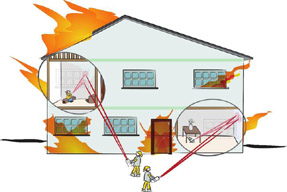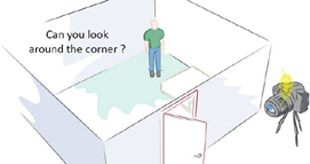Spanish scientists, in collaboration with researchers from America, have designed the first camera that is capable of capturing slow movement of light and photograph objects that may be hidden behind a corner or in a shady environment ie. smoke and fire.
Thanks to this system, Firefighters would have the ability to see if there are persons in a room with smoke or indeed if the room is empty.

The system is called “Femto-Photography”.
This product could end up being used in complicated search and rescue operations and also for medical imaging purposes. It is capable of passing through body tissue,similar to an X-Ray but not harmful to the body.

"Femto-Photography” will be able to detect objects hidden from view around a wall or corner without it having to be in the direct line of view.
Diego Gutierrez ,Researcher of the Institute of Engineering Research at Aragon, University of Zaragoza, along with scientists from the Media Lab Institute of Technology Massachussets, U.S.A. participated in the design of this prototype system, which has attracted the attention of researchers worldwide.
The camera, which features a laser with a “femtosecond” frequency, is able to capture a "billion frames per second", allowing you to see how light propagates itself, Gutierrez has told EFE.
Gutierrez stated “Currently, image capture devices cannot photograph the movement of light, due to its speed (300,000 kms per second).
However, this camera slows down time, until a factor of 15,000 million, which allows you to view, for example, how the light goes off bulb and spreads through the rest of the room, and from there, enter a new visual information.
"It is the slower camera that exists. No one had been able to see how light travels at 300,000 kilometers per second", he commented.
From now on, the goal of the groups participating in the project, also I3A, is to apply this technique, which now exists only in the laboratory, to other areas.
It has a great potential, according to Gutierrez, because you get to photograph a hidden object behind a corner, something impossible for other mechanisms, as they have some periods of "huge" shutter, compared to the speed of light.
Let us say your cat is hidden around the corner, the laser will bounce off whatever surface (like the wall) to hit the animal, and then light will travel back the same route.
As you are able to do this, this system will also allow you to see through turbid media, such as smoke or water, which would facilitate the work, in a fire or in an underwater rescue. For example, Search Teams would have the ability to look into a smoky room, in which you cannot usually see anything. They would be able to detect persons or discover it to be empty.
It would assist in their searching techniques without losing too much time!
Gutierrez added: “In the medical field problems can be similar because tissue scatters light, so much so that the coherence of the image is lost and not displayed but the information is present". "X-rays are able to overcome this boundary and penetrate tissue, without this dispersion occurs; but must be used with "caution" because they cause damage", he said. However, in theory, this unit may irradiate the body with normal light and obtain the same information, provided by the X-rays, but without being harmful to the organism.
This research, published by Diego Gutierrez and scientists from MIT Media Lab, has attracted the attention of China, where the government has spent ten of millions of euros, to advance this line, said Gutierrez.
Meanwhile, Spain is “holding back", whilst a year ago it was “on the "grid", of this project but now according to Gutierrez “public and private administrations are not being to research”.
The I3A have 31,000 euros for a year, thanks to a grant from the BBVA Foundation; but, in order that some of these applications are a reality, it requires "at least five years", so that Gutierrez continues looking for other funding sources.
Well, I think it is so interesting and I hope these researchers can make this project a reality.
Until my next post, kind regards,
Luis.
Sponsored by Costaluz Lawyers.
Please click below:
